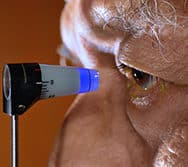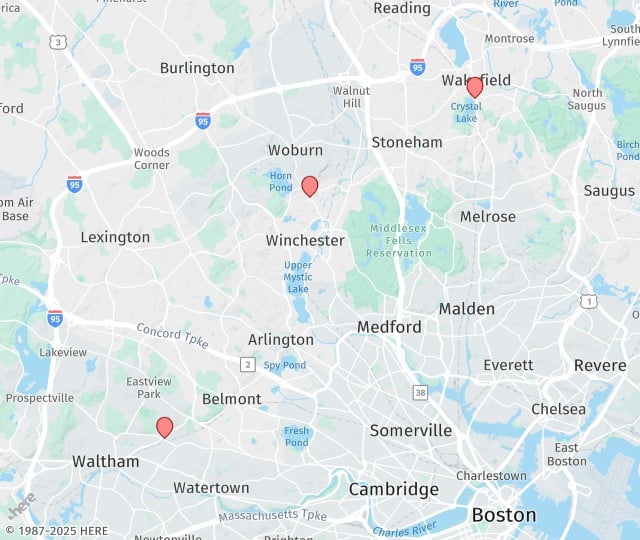What Is Glaucoma?
Glaucoma is a common eye disease which causes loss of vision in individuals affected by the condition. Glaucoma develops when the pressure of the fluid inside the eye gets too high. Fluid enters the eye at a structure called the ciliary body and exits the eye at a structure called the trabecular meshwork.

With glaucoma, there is a problem with fluid draining normally from the eye. When the pressure inside the eye builds up, damage to the optic nerve develops where the nerve enters the back of the eye. Several forms of glaucoma exist, and each is treated differently. Patients with a family history of glaucoma are at increased risk for the development of this condition. Our Boston glaucoma experts can diagnose and treat this condition.
Types of Glaucoma
There are generally two types of glaucoma that a patient may be diagnosed with. These include open-angle glaucoma and narrow-angle glaucoma.
Open-Angle Glaucoma
Open-angle glaucoma (OAG) is the most common form of glaucoma that patients suffer from. This type of glaucoma occurs due to the eye not draining fluid as well as it should, similar to a clogged drain in your home. The American Academy of Ophthalmology believes that OAG may occur as a result of inadequate blood supply to the optic nerve or due to inefficient aqueous humor drainage. OAG generally affects the vision in both eyes and can result in the loss of a significant portion of the patient’s vision before they even notice.
Narrow-Angle Glaucoma
The fluid of the eyes typically drains out through a system of canals that are located in the mesh of tissues between the cornea and the iris. When a shifting occurs between these two components, it closes the angle between them, resulting in the complete blockage of the canals. When this happens, patients can experience acute attacks due to a rapid increase of pressure building up in the eye caused by inadequate drainage. The pressure ultimately damages the optic nerve, resulting in complete vision loss if not treated in time.
Differences Between Open-Angle and Narrow-Angle Glaucoma
One of the key differences between open-angle glaucoma and narrow-angle glaucoma is the symptoms that patients experience. With OAG, patients generally live with the disease extensively without it being formally diagnosed. With narrow-angle glaucoma, the symptoms present themselves immediately.
What Causes Glaucoma?
Research into the causes of glaucoma has been going on for many years. Some studies suggest that the risk for this condition could be inherited, as it can be seen in family lines. Our doctors know that glaucoma involves increased intraocular pressure caused by the buildup of fluid in the eye. This could happen due to a blockage in the mesh-like channel through which fluid drains from the eye. However, no clear cause has yet been found.
While excessive pressure in the eye is a contributing cause of glaucoma, there are some cases in which the optic nerve sustains damage in the absence of elevated intraocular pressure. Conversely, not everyone with increased intraocular pressure develops glaucoma. Continued research is needed to better understand the underlying factors that cause this condition.
Because glaucoma can be so discreet, all adults must maintain periodic eye exams from an ophthalmologist. A full exam should include routine testing as well as the direct examination of the optic nerve.
"Very competent and professional – took care of me right away. Friendly staff. Would recommend to anyone."
What Is Considered Normal Eye Pressure?
Intraocular pressure between 12 and 22 mm Hg is considered normal. The “mm Hg” refers to millimeters of mercury, the scale used to measure eye pressure. Intraocular pressure can change throughout the day due to several factors. Fluctuations are normal but can present a threat to the optic nerve when they linger at the upper level. There are also instances in which glaucoma occurs even when eye pressure is within the normal range. This is referred to as normal-tension glaucoma. Because glaucoma can occur without elevated eye pressure, it is important to have routine dilated eye exams that evaluate the optic nerve.
What Are The Symptoms Of Glaucoma?
The signs of glaucoma correlate with the type of glaucoma a person has and the severity of their condition.
Open-Angle Glaucoma May Cause:
- Patchy blind spots in central or peripheral (side) vision. This often affects both eyes.
- Tunnel vision occurs when this type of glaucoma worsens.
Acute Angle-Closure Glaucoma May Cause:
- Blurred vision
- Severe headache
- Eye redness
- Halos around lights
- Eye pain
- Nausea and vomiting
Can Glaucoma Be Caused By Stress?
Glaucoma is generally related to a functional failure in the balance between fluid production in the eye and the drainage of that fluid. The eye is like a basketball or beach ball. It requires pressure to maintain its shape. In the case of a beach ball, that shape is maintained with air pressure. In the eye, pressure comes from the aqueous fluid. When something goes awry with the internal eye structures, intraocular pressure can become dysregulated, leading to extraordinarily high pressure, glaucoma.
There are also instances of normal-tension glaucoma, in which the pressure in the eye falls in the normal range. It is not known exactly what causes this condition. However, some research points to a decrease in blood flow to the optic nerve as a factor in the progression of normal-tension glaucoma. Further data suggest that the emotional state of a person can affect intraocular pressure and therefore contribute to the severity of glaucoma.
Can stress cause glaucoma? Current evidence is inconclusive. However, because emotions and intraocular pressure seem to be interrelated, patients with glaucoma may benefit from stress management practices such as breathing exercises.
How Is Glaucoma Diagnosed?
To diagnose glaucoma, an ophthalmologist will conduct a thorough consultation in which your medical history is reviewed. A comprehensive eye examination is also performed. During the eye exam, specific tests may be performed. These include:
- Tonometry, which measures intraocular pressure (pressure inside the eye)
- Visual field test, which checks for central and peripheral vision loss
- Pachymetry, which measures the thickness of the cornea
- Gonioscopy, which evaluates the drainage angle of the eye
- Observation of the optic nerve while the eyes are dilated
- These tests do not take long and are not painful. Measurements are recorded and pictures may be taken to future comparison.
The Potential Impact Of Glaucoma On Your Life
Although patients can be depressed at the onset of this disease it is important to not be consumed with the negative aspects. This eye disease does not have to limit your lifestyle. Continue with regular activities and try not to be consumed with the emotional aspects of having a disease. If you have a business, start new initiatives; if you play golf, go hit some golf balls or if you enjoy cooking, try some new recipes.

There may be some physical activities such as sports or even driving, that may become harder for you to do. It is common for some glaucoma patients to experience light sensitivity or specific problems with light glare. Because driving can potentially endanger others, it is important to discuss your condition with your eye doctor.
What Foods Should I Avoid If I Have Glaucoma?
Multiple studies have shown that various foods have specific effects on the body. For people with health conditions like glaucoma, it is beneficial to know what these effects may be, especially as they relate to the eyes. Some foods that can affect eye health include:
- Trans-fatty acids. These are commonly found in packaged foods like cookies, and also in fried foods. Trans-fatty acids can increase cholesterol levels, which can then damage blood vessels. There are many small blood vessels in the eyes that are involved in feeding the optic nerve.
- Foods that cause allergies, such as soy, dairy, wheat, and corn.
- Saturated fats, which may be found in fatty cuts of red meat, may worsen glaucoma.
- Coffee. People with glaucoma or other forms of elevated intraocular pressure should limit their intake of coffee. This beverage has been associated with increased pressure in the eyes.
- Complex carbohydrates. Examples include cereal, rice, pasta, bread, and potatoes. These foods can increase insulin levels, which can cause weight gain and damage to the small blood vessels in the eyes.
What Happens If Glaucoma Goes Untreated?
The eye disease of glaucoma can be very problematic to your vision, and it is the second-leading cause of blindness in the U.S. Glaucoma must be taken seriously.
"I’ve been a patient for many years being treated for glaucoma. Dr. Evans and the entire staff are superb. Treatment including laser surgery has been very effective in reducing and maintaining correct eye pressure."
Can People of Any Age Get Glaucoma?
Glaucoma is a condition that can occur at any age. However, the majority of patients diagnosed with this condition are older adults. In fact, glaucoma is one of the leading causes of blindness in patients over the age of 60 in the United States.
There are certain factors that increase the risk of glaucoma.
Who’s At Risk For Glaucoma?
Glaucoma can impact anyone or any family. All people should be concerned about the glaucoma disease and the potential harm it could cause someone’s life. Because this eye disease is also known as the sneak thief of sight we must remind each other, especially our elders, to get regular eye examinations. Early detection could save your vision.
People at greater risk for glaucoma:
- People of African-American descent
- Adults over the age of 50 years
- Those with a significant family history of glaucoma
- People who have diabetes
- Nearsighted patients
- People with high intraocular pressure
- Those with Asthma (Corticosteroids inhaled to treat asthma have been reported to raise intraocular pressure)
The American Academy of Ophthalmology (AAO) now recommends that people with other risk factors for glaucoma have their eyes examined.
Glaucoma Treatment Options
If you have glaucoma and would like to discuss alternative and modern glaucoma treatment options our doctors are readily available for discussion. If you are concerned that serious damage is occurring from glaucoma do not hesitate to schedule an appointment with us in the greater Boston area. Our treatment options include:
Non-Invasive Glaucoma Treatments
Once you have been diagnosed with glaucoma you will need to make simple lifestyle changes in order to manage your disease. If you have been diagnosed at an early point the eye doctor will then make a suggested treatment protocol based on taking medication to control intraocular pressure. Once the treatment protocol for medications is administered patients can typically return to a normal life. Taking medication will be critical or the disease can progress. Glaucoma patients typically struggle with integrating all of the medicating times into one day. Successful patients often try to take the medicine or drops at times such as waking up, before bed, or during meals and snacks
Glaucoma Laser Treatment
At North Suburban Eye Associates, we have doctors that specialize in glaucoma treatment as well as uveitis, an eye condition related to inflammation in the eye. Our doctors are skilled with many of the glaucoma lasers needed for the treatment of narrow and open-angle glaucoma.
Glaucoma Surgery
Glaucoma surgery is also an option. We have experience performing glaucoma surgeries, including shunts and filters, for the treatment of moderate to severe glaucoma in the Stoneham surgery center
Pros and Cons of Glaucoma Treatment Options
When it comes to determining the best glaucoma treatment for you, it is important to know that there are some pros and cons with each of the options available.
Non-invasive treatment options work well for relieving pressure in the eye and reducing the symptoms of some forms of glaucoma. However, they can cause changes in energy levels and breathing and can result in eye redness and discoloration of the skin.
Laser treatment can help improve vision when eyedrops do not provide relief for symptoms associated with open-angle or closed-angle glaucoma. These treatment options are typically pain-free and provide relief for patients more quickly than eyedrops. Like other treatments, there are possible side effects from laser treatment. Patients may experience some swelling and soreness. If the laser scratches nearby sections of the eye, patients may experience some pain. However, these symptoms typically subside quickly. Laser treatment may provide faster relief for patients as opposed to other treatment methods.
Glaucoma surgery is another option that patients may have for treating their condition. Surgery can result in some side effects, such as swelling and soreness. However, this treatment does provide faster relief for patients. Unfortunately, surgery can only be performed on one eye at a time, so patients will have to go through two separate surgical procedures to address problems in both eyes. Thankfully, glaucoma surgery does have a very high success rate when it comes to lowering pressure in the eye.
It is important to discuss your options with our doctor to determine the best glaucoma treatment options for you based on your individual circumstances.
Are Glaucoma Treatment Results Permanent?
Glaucoma is a condition that damages the optic nerve. Early treatment is critical because, once the optic nerve is damaged, the repair is not possible. In some cases, medications are prescribed to reduce and manage intraocular pressure. This can slow the progression of damage to the optic nerve or halt it for some time. It is important to understand that there is no cure for glaucoma. Surgery is often necessary to achieve long-term results. However, surgery is also not a permanent solution. Because glaucoma is often a symptom of poor fluid drainage from the eye, the condition will continue to some extent after surgery.
Is Glaucoma Painful?
The most common form of glaucoma, open-angle glaucoma, usually does not involve painful symptoms. This is why the condition can be so difficult to catch early if routine eye exams are not performed. In open-angle glaucoma, eye pressure typically increases quite slowly. It is believed that this contributes to the painlessness of the condition. The first indication of this form of glaucoma is usually some degree of vision loss.
Acute angle-closure glaucoma is different. This condition may occur as a type of glaucoma attack in which eye pressure increases rapidly and severely. An acute angle-closure glaucoma attack may involve severe pain that triggers nausea or vomiting. Patients may also notice decreased vision due to the effect this attack has on the cornea. Acute angle-closure glaucoma attack is a medical emergency that requires prompt treatment.
How Can Glaucoma Be Prevented?
It may not be possible to completely prevent glaucoma. However, steps may be taken to increase the chances of detecting glaucoma early so vision can be preserved.
- Regular dilated eye exams–It is not enough to undergo basic vision screenings each year. A full, dilated eye exam should be done once every year or once every two years for people 60 or older. If you are younger than 60, your eye doctor will recommend a dilated eye exam based off the health of your eyes.
- Know your family history of eye disease– Because glaucoma may be passed down through generations, it is beneficial to know if this condition runs in your family. This would indicate the value of more frequent dilated eye exams.
- Eye protection– Eye injuries can increase the risk of glaucoma. Wearing protective eye gear when working outdoors or playing sports is recommended.
- Exercise regularly and safely– Moderate exercise is good for the eyes and may help reduce intraocular pressure. However, if you have glaucoma, your doctor may advise you to avoid certain exercises that would increase eye pressure, such as handstands or headstands.
- Use prescribed eye drops as directed– If you have been diagnosed with glaucoma but are not exhibiting symptoms, you still need to use your prescribed eye drops as directed. This can help slow the progression of the disease.
Is Glaucoma Treatment Covered By Insurance?
Yes. Glaucoma is an eye disease that is typically covered under a person’s medical insurance plan, not their vision insurance.
Schedule A Consultation For Boston Glaucoma Treatment
If you suspect that you might have glaucoma or have been previously diagnosed as a glaucoma patient please contact our office immediately to consult with our staff or the dedicated surgeons at North Suburban Eye Associates at any of our 3 locations in the greater Boston area (Wakefield, Winchester, and Waltham).
Our doctors are at the forefront of glaucoma treatment and diagnosis. If you want immediate attention please call our office at 781-245-5200 or fill out our contact us form for an appointment. North Suburban Eye Associates is your source for glaucoma treatments in the greater Boston area. Because we specialize in treating and managing this eye disease we have a unique perspective and opportunity to help our patients live with glaucoma.


